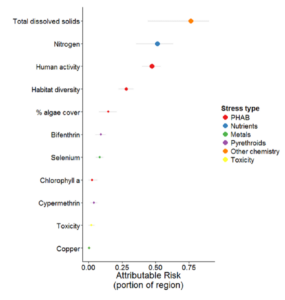The SMC’s Regional Watershed Monitoring Program has paved the way for managers to understand at a regional scale the ecological condition of wadeable streams across coastal southern California.
The first decade of SMC regional monitoring found that three-fourths of the region’s stream-miles are considered to have their biological communities altered by human activities.
With these insights, managers need to figure out which stressors are the major players in contributing to observed biological degradation.
SMC regional monitoring is helping managers to get these answers. Based on an analysis of the SMC’s first decade of regional monitoring data, the stressors that were most strongly associated with degraded biological condition are:
- Nutrients
- Major ions
- Degraded habitat
The stressors that were limited or weakly associated with biological condition are:
- Metals
- Toxicity
- Water-column pyrethroids
Having these insights helps managers develop informed priorities and take informed actions to optimally reduce and mitigate stressors impacting stream biology.
A technical report summarizing the first five years of the SMC’s regional bioassessment monitoring program offers a closer look at how researchers determine which stream stressors are more vs. less strongly associated with biological degradation.

